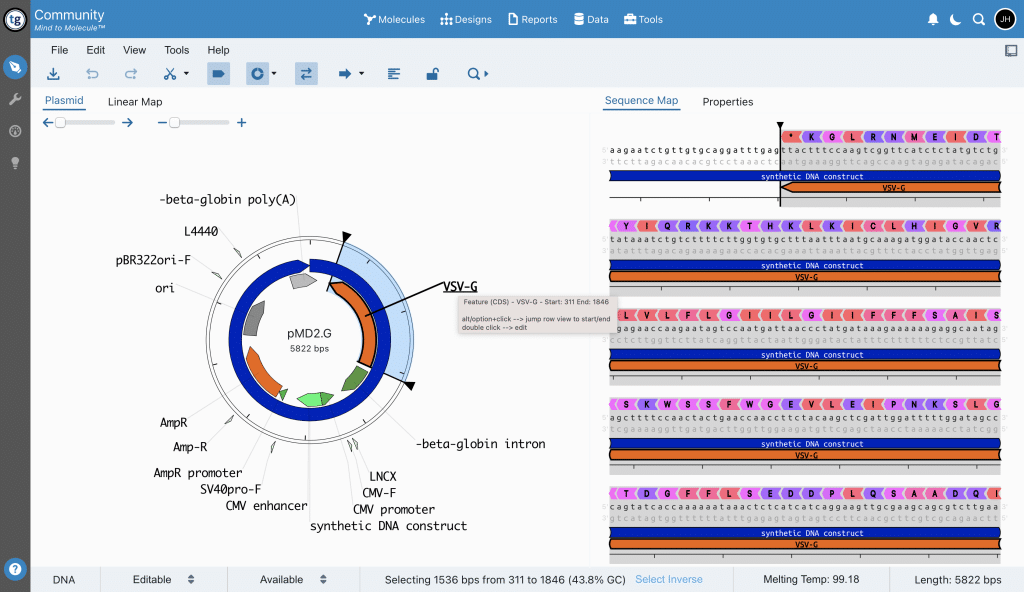What are plasmids? Plasmids are a crucial tool for molecular cloning in genetic engineering. They are small, circular, double-stranded DNA molecules that can replicate independently within bacterial cells. Plasmids can be modified with a variety of genetic elements, making them versatile vehicles for gene expression, protein production, and more. In this article, we will discuss five popular plasmids that are commonly used in molecular cloning.
5 popular plasmids
- pMD2 G is a high-efficiency expression vector commonly used for mammalian cell transfection. It is derived from the pUC19 plasmid and contains a strong cytomegalovirus (CMV) promoter for efficient gene expression. pMD2.G also carries the ampicillin resistance gene, which allows for antibiotic selection. The plasmid has a length of 5,822 base pairs and can be purchased from Addgene here. The GenBank file for pMD2.G can be found here.
- pUC57 is a cloning vector that is widely used for subcloning and sequence verification and commonly used in E. coli. It is a derivative of the pUC18 plasmid and has a multiple cloning site (MCS) for easy insertion of DNA fragments. pUC57 also contains the ampicillin resistance gene and a lacZα sequence for blue/white screening. The plasmid has a length of 2,710 base pairs and can be purchased from GenScript here. The GenBank file for pUC57 can be found here.
- pET15b is a popular expression vector used for protein purification. It contains an N-terminal His-Tag that allows for simple and efficient protein purification using nickel affinity chromatography. PET15b also has the ampicillin resistance gene for antibiotic selection. The plasmid has a length of 5,708 base pairs and can be purchased from Merck Millipore here. The GenBank file for PET15b can be found here.
- pET22b is a popular plasmid for protein expression in E. coli. It is similar to pET15b, but has a different linker region and an additional thrombin cleavage site that allows for easier purification of recombinant proteins. pET22b is commonly used for producing proteins with N-terminal His-tags, and like pET15b, it is designed for high-level expression under the control of the T7 promoter. It confers resistance to ampicillin and contains NcoI and XhoI cloning sites. The plasmid is 5,493 base pairs in length and is available from Merck Millipore here. The GenBank file for pET22b can be found here.
- pET28a is a high-level expression vector used for recombinant protein production in E. coli. It carries an N-terminal His-Tag for protein purification and a T7 promoter for strong gene expression. pET28a also contains the kanamycin resistance gene for antibiotic selection. The plasmid has a length of 5,369 base pairs and can be purchased from Merck Millipore here. The GenBank file for pET28a can be found here.

TeselaGen is a platform that offers a comprehensive solution for molecular cloning. It is compatible with all of the plasmids discussed in this article and provides automatic assembly instructions, including the primer and PCR sequences needed. TeselaGen supports various cloning methods, such as infusion cloning and Golden Gate assembly, making molecular cloning easier and more efficient.
| Plasmid Name | Length (bp) | Resistance | Expression System | Vendor | GenBank File | Summary |
| pMD2 G | 5,822 | Ampicillin | CMV promoter | Addgene | Addgene: pMD2.G Sequences | High-efficiency expression vector commonly used for mammalian cell transfection. |
| pUC57 | 2,710 | Ampicillin | N/A | GenScript | Cloning vector pUC57, complete sequence | Cloning vector that is widely used for subcloning and sequence verification and commonly used in E. coli. |
| pET15b | 5,708 | Ampicillin | T7 promoter | Merck Millipore | pET15b | Popular expression vector used for protein purification. |
| pET22b | 5,493 | Ampicillin | T7 promoter | Merck Millipore | pET22b (Not annotated) | Popular plasmid for protein expression in E. coli. |
| pET28a | 5,369 | Kanamycin | T7 promoter | Merck Millipore | pET-28 a (+) | High-level expression vector used for recombinant protein production in E. coli. |
It’s important to note that there may be variations in the attributes of these plasmids depending on the specific version or source obtained from vendors. Therefore, it’s always recommended to double-check the specifications of each plasmid before purchasing or using it.
As mentioned in the article, TeselaGen’s platform allows the use of all of these plasmids (and more) and can generate assembly instructions automatically for users, including primer and PCR design for different cloning methods such as In-Fusion cloning (sometimes incorrectly spelled as infusion cloning), Gibson assembly and Golden Gate. This can greatly simplify and accelerate the process of designing and cloning DNA constructs for research and industrial purposes.
To learn more about how TeselaGen’s platform powers DNA design and engineering visit TeselaGen’s DNA Design site, if you want to start designing DNA efficiently right away for free try TeselaGen’s Community Edition and for everything else check TeselaGen’s main site!
